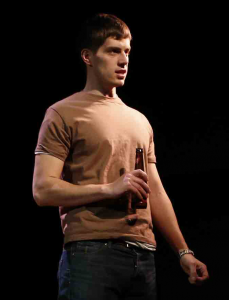The Caucasian Chalk Circle, one of Bertolt Brecht’s most acclaimed dramas, provides an excellent example of the difference in Brecht’s theater from that of dramatists before him, or indeed, most of them since. If one expects a “big secret” to be revealed at the end of The Caucasian Chalk Circle—Mom is a morphine addict, Dad’s munitions were faulty—disappointment is inevitable. Brecht’s narrative strain of theater concentrates on instruction.
Chalk Circle, drawn from a Chinese parable and a Biblical one, is divided into two parts. In the first, Grusha (Elizabeth A. Davis), a servant in the house of Georgi Abashvili, the governor of a province in Georgia, in the Caucasus, rescues the governor’s child, whose life is endangered by a civil conflict. The child’s mother, Natella Abashvili, given brassy, bossy life by the inimitable Mary Testa, is obsessed with taking belongings with her in escaping the uprising, and she forgets her child. Grusha endures various challenges in her attempt to ensure the child’s safety. She crosses a dangerous bridge and ends up marrying a dying man to give the babe a stable home, but ultimately she is discovered and the child is taken from her. In the second half, she goes to court to fight for parental rights, although Natella wants her son back. Rendering judgment is the cynical Azdak (Christopher Lloyd), a former peasant and philosopher who takes bribes and often delivers unexpected verdicts. Which of the two women has the right to be the mother?
Brian Kulick’s production takes un-Brechtian liberties with the translation by Brian and Tania Stern. The realism advocated by Brecht is liberally sprinkled with symbolism—a chair, bed headboard, red rocking horse and other objects hang from the flies, and characters frequently break the fourth wall, sometimes for interactivity, which is currently a mini-mania on New York stages. Whether Brecht would have approved of audience members getting on stage to enact a wedding party is uncertain, but, fortunately, most of Kulick’s gimmicks don’t sabotage the playwright. The “alienation effect” advocated by Brecht—an insistence on keeping the audience aloof so that their emotional investment in the characters doesn’t trump their absorbing the political and social comment of the plays—is enhanced by the meddling.
Moreover, some of Kulick’s inventions provide a rough magic. The suitcases piled up by Natella in an early scene (though not in any way “trunks,” as the text has it) are later reconfigured to become the rotted slats of a footbridge that Grusha has to cross, and later still to become a stream separating Grusha from the man who loves her, Simon Chachava. A simple moment of Lloyd, who doubles as the Singer/narrator, sprinkling snowflakes over Grusha is as effective as Matt Kraus’s sound design for a scene when the snows melt and Grusha is about to be turned out of her brother’s home. The plinks of drops falling into buckets as ice melts becomes deafening as the brother (Tom Riis Farrell, in the best performance of several roles he has) tells her she must leave when spring comes.
Tony Straiges’ set design is equally impressive: the back walls are painted with Soviet-style murals of outsize workers and Cyrillic lettering (Kulick has re-set the play from the 1930s to after the 1989 fall of Communism). A huge statue of Lenin upstage is broken apart early on with ropes from the flies, and its ruins make an impressive backdrop to subsequent events. And Spring Awakening composer Duncan Sheik has composed impressively apt, folk-tinged music for the songs (lyrics by W.H. Auden) interspersed in the play.
Davis makes a resourceful, feisty Grusha, and Alex Hurt as the lovelorn, bashful Simon delivers the most nuanced performance. The other actors have their moments, but often play in broad strokes. Testa is as officious as a peasant mother as she is as Natella; she barks and snarls intimidatingly. Farrell as a corporal gives his yelling voice a workout as well. Among the others, Deb Radloff is particularly amusing as Ludovica, a young woman charging rape who appears before Azdak, though his judgment will garner more revulsion nowadays than laughter.
Azdak, however, is a tough role, and Lloyd is hampered by a guttural voice that’s not always pleasant to listen to, especially in a long monologue at the top of Act II. He works hard at making Azdak humorous, growling and leering persuasively, and goggling his eyes, but neither the actor’s efforts nor Kulick’s goosing prevent one of Brecht’s sunnier pieces from being grimmer than necessary. At the climax, at least, Lloyd has an amusing byplay with audience members that lightens the tone. Though there’s a lot of un-Brechtian ornamentation in this production, the play still works.






















